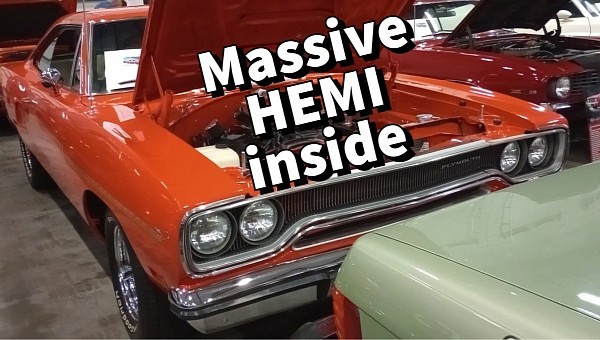Originally conceived as relatively affordable and powerful automobiles, most muscle cars became more expensive by 1968 as automakers began adding more premium features. Following the introduction of the GTX as a rival to the fancied-up Charger in 1967, Plymouth launched the lower-priced Road Runner for the 1968 model year.
Devoid of most features found in the GTX, but offered with the same high-performance, big-block V8 engines, including the mighty 426-cubic-inch (7.0-liter) HEMI, the Road Runner was an instant hit. The nameplate moved almost 45,000 units in its first year on the market, outselling the GTX by a ratio of almost 2.5 to 1. In 1969, Road Runner sales almost doubled to 84,510 units, almost 5.5 times more than the GTX.
Come 2023 and the Road Runners is one of the most iconic vehicles from the golden muscle car era, while HEMI examples are among the rarest and most expensive. That's because Plymouth sold only 2,003 HEMI-equipped cars over four model years. The 1971 version is the rarest, at only 55 units built, while the 1970 variant is a close second, at 152 examples made. When in excellent condition, HEMI cars change hands for more than $100,000 a pop.
The high prices and the limited availability of these cars have prompted many enthusiasts to build their own HEMI clones. And the example you see here is proof that taking this route is a great idea when done right.
A perfectly restored example finished in Vitamin C, one of Chrysler's most beloved "high impact" colors from the golden era, this Road Runner may look like a run-of-the-mill example in the absence of an Air Grabber hood. But don't let the plain engine lid fool you, that white-striped piece of steel hides a very special mill.
Nope, I'm not talking about a 426 HEMI, which is indeed special and rare, but a bigger, custom-built version of the same powerplant. Put together by VanGordon Racing, a shop specialized in pre-1974 hot rods and muscle cars, this HEMI V8 displaces a whopping 540 cubic inches (8.8 liters).
And it's not only about taking up more space in the engine bay because this beefed-up V8 cranks out 735 horsepower. That's 310 horses more than the legendary 426 HEMI, which is spectacular, to say the least. That's also more than double the amount of the 383-cubic-inch (6.3-liter) V8 this Road Runner got from the factory.
To handle all that extra oomph, the Mopar was also fitted with disc brakes at all four corners and rides on a stiffer Edelbrock suspension. An upgraded four-speed manual gearbox routes the power to the wheels through a Dana 60 rear end with 3.73 gears. Needless to say, this Road Runner is ready to cover the quarter mile quicker than the average modern muscle car.
And the fact that it looks like a plain Plymouth equipped with a front bench seat makes it even cooler. It's the perfect sleeper in my book, so go ahead and check it out in the video below.
Come 2023 and the Road Runners is one of the most iconic vehicles from the golden muscle car era, while HEMI examples are among the rarest and most expensive. That's because Plymouth sold only 2,003 HEMI-equipped cars over four model years. The 1971 version is the rarest, at only 55 units built, while the 1970 variant is a close second, at 152 examples made. When in excellent condition, HEMI cars change hands for more than $100,000 a pop.
The high prices and the limited availability of these cars have prompted many enthusiasts to build their own HEMI clones. And the example you see here is proof that taking this route is a great idea when done right.
A perfectly restored example finished in Vitamin C, one of Chrysler's most beloved "high impact" colors from the golden era, this Road Runner may look like a run-of-the-mill example in the absence of an Air Grabber hood. But don't let the plain engine lid fool you, that white-striped piece of steel hides a very special mill.
Nope, I'm not talking about a 426 HEMI, which is indeed special and rare, but a bigger, custom-built version of the same powerplant. Put together by VanGordon Racing, a shop specialized in pre-1974 hot rods and muscle cars, this HEMI V8 displaces a whopping 540 cubic inches (8.8 liters).
And it's not only about taking up more space in the engine bay because this beefed-up V8 cranks out 735 horsepower. That's 310 horses more than the legendary 426 HEMI, which is spectacular, to say the least. That's also more than double the amount of the 383-cubic-inch (6.3-liter) V8 this Road Runner got from the factory.
To handle all that extra oomph, the Mopar was also fitted with disc brakes at all four corners and rides on a stiffer Edelbrock suspension. An upgraded four-speed manual gearbox routes the power to the wheels through a Dana 60 rear end with 3.73 gears. Needless to say, this Road Runner is ready to cover the quarter mile quicker than the average modern muscle car.
And the fact that it looks like a plain Plymouth equipped with a front bench seat makes it even cooler. It's the perfect sleeper in my book, so go ahead and check it out in the video below.













